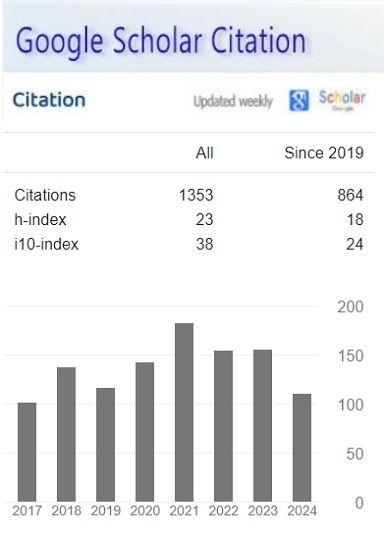Characterization and Application of Phytochemicals Substances of the Fig Tree: Biological and Sensory Characterization of Ficin and Cheeses “Fresh and Soft”
Keywords:
Abstract
The manufacture of cheese based on goat's milk is a traditional practice using fig tree latex. The objective of this paper is to study the possibility of substituting rennet with ficin as a vegetable coagulant milk and its characterization. In addition, two trials of manufacturing fresh and soft cheese using ficin were made. The results obtained show that the coagulant activity of ficin is optimal at pH = 5, at a temperature of 75℃ and at a CaCl2 concentration of 0.03 M with 2097.90 UR., 911.79 UR., and 192.30 UR respectively. The coagulant force of this enzyme is 1/21250.911 with a proteolytic activity estimated at 139 μg of tyrosine equivalent per ml of ficin extract. The fresh cheese is white with a creamy appearance and great solubility in the mouth. The ficin soft cheese has an organoleptic quality better than that of control cheese and a softer with a more viscous texture in comparison to that of rennet. The ficin soft cheese has a penetrometry of 2.5 mm in comparison with that of a rennet of 3.6 mm. Ficin can replace rennet in cheese making and deserves to be expanded in the manufacture of different cheeses.
References
Bekhit A, David L, Hopkins, Geesink G, Bekhit AA and Philip F (2013) Exogenous proteases for meat tenderization. Critical Reviews in Food Science and Nutrition. 89p. DOI: https://doi.org/10.1080/10408398.2011.623247
Berridge NJ (1955) Purification and assay of rennin. Methods in enzymology. Ed. Perlmann G.E. and Loran Acad. Press Inc., New York. (Volume 2: 69-77). DOI: https://doi.org/10.1016/S0076-6879(55)02171-X
Biswajit P, Marufa N, Animesh S and MD Rafiad I (2013) Isolation, purification and modification of papain enzyme to ascertain industrially valuable nature. International Journal of Bio Technology and Research, Volume: 3(5): 11-22.
Faccia M, Picariello G, Trani A, Loizzo P, Gambacorta G, Lamacchia C and Di Luccia A (2012) Proteolysis of Cacioricotta cheese made from goat milk coagulated with caprifig (Ficus carica sylvestris) or calf rennet. European Food Research and Technology, (Volume 234: 527– 533). DOI: https://doi.org/10.1007/s00217-012-1668-0
Fadyloglu S (2001) Immobilization and characterization of ficin. Nahrung/Food, (Volume 45 (2): 143– 146). DOI: https://doi.org/10.1002/1521-3803(20010401)45:2<143::AID-FOOD143>3.0.CO;2-8
Feijoo SL and Villa TG (2010) Native and Biotechnologically Engineered Plant Proteases with Industrial Applications. Food BioprocessTechnology, Volume 4(6): 1066-1088. DOI: https://doi.org/10.1007/s11947-010-0431-4
Feijoo SL, Blasco L and Luis RJ (2014) Recent patents en microbial proteases for the dairy industry, Volume 1 (8): 44-55. DOI: https://doi.org/10.2174/2352092208666141013231720
Fox Patrick F, Guinee Timothy P, Timothy M, Cogan and McSweeney Paul LH (2000) Fundamentals of Cheese Science. An Aspen Publication Inc. Gaithersburg, Maryland. P 559.
Huppertz T, Upadhyay VK, Kelly AL and Tamime AY (2006) Constituents and properties of milk from different species. Brined Cheeses. Edited by Dr Adnan Tamime. Copyright © 2006 by Blackwell Publishing Ltd. (Pp 1-34). DOI: https://doi.org/10.1002/9780470995860.ch1
Laitier C, Chatelin YM, Doutari E, Barrucand P, Duchesne C, Morge S, Barral J, Cuvillier D, Minard L and Leroux V (2009) Evaluation et maitrise de la texture des fromages frais de chèvre à coagulation lactique. Rencontre Recherche Ruminants, Volume 16: 143-146.
Libouga DG, Vercaigne-marko D, Djangal SL, Choukambou I, Ebangi AL, Ombionyo M, Beka RG, Aboubakar TM and Guillochon D (2006) Mise en évidence d’un agent coagulant utilisable en fromagerie dans les fruits de Balanites aegyptiaca. Tropicultura, Volume 24: 229-238.
Nouani A, Dako E, Morsli A, Belhamiche N, Belbraouet S, Bellal MM and Dadie A (2009) Characterization of the purified coagulant extracts derived from artichoke flowers (Cynarascolumus) and from the fig tree latex (Ficus carica) in light of their use in the manufacture of traditional cheeses in Algeria. Journal of Food Technology, Volume 7: 20-29.
Oliveira AP, Baptista P, Andrade PB, Martins F, and Pereira JA (2012) Characterization of Ficus carica L. cultivars by DNA and secondary metabolite analysis: Its genetic diversity reflected in the chemical composition. Food Research International, Volume 49: 710-719. DOI: https://doi.org/10.1016/j.foodres.2012.09.019
Oner MD and Akar B (1993) Separation of the proteolytic enzymes from fig tree latex and its utilization in Gaziantep cheese production. Lebensm-Wiss. Und Technology, (Volume 26: 318-321). DOI: https://doi.org/10.1006/fstl.1993.1065
Payne TC (2009) Enzymes in Meat Systems Enzymes. Chapter 8. R. Tarté (Ed.), Ingredients in Meat Products Properties, Functionality and Applications. 26p. DOI: https://doi.org/10.1007/978-0-387-71327-4_8
Solomon A, Golubowicz S, Yablowicz Z, Grossman S, Bergman M, Gottlieb HE, Altman A, Kerem Z and Flaishman MA (2006) Antioxidant activities and anthocyanin content of fresh fruits of common fig (Ficus carica L.). Journal of Agricultural Food Chemistry, (Volume 54: 7717-7723). DOI: https://doi.org/10.1021/jf060497h
Vignola CL (2002) Science et technologie du lait, transformation du lait. Presses internationales polytechnique, Québec; 608p.
Williams Donald C, Sgarbieri Valdemiro C and Whitaker John R (1968) Proteolytic Activity in the Genus Ficus. Plant Physiology, (Volume 43: 1083-1088). DOI: https://doi.org/10.1104/pp.43.7.1083
Zare H, Moosavi-Movahedi AA, Salami M, Mirzaei M, Saboury AA and Sheibani N (2013) Purification and autolysis of the ficin isoforms from fig (Ficus carica) latex. Journal phytochemistry: 16. DOI: https://doi.org/10.1016/j.phytochem.2012.12.006
Downloads
Published
How to Cite
Issue
Section
License
Copyright (c) 2020 Asian Journal of Applied Science and Engineering

This work is licensed under a Creative Commons Attribution-NonCommercial 4.0 International License.








